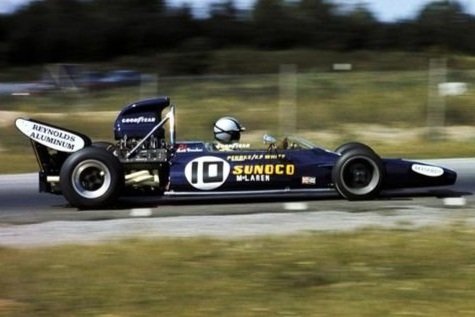#6 Mark Donohue
Born in New Jersey in 1937, Donohue was intellectual and excelled in school. He attained a mechanical engineering degree from Brown University, and this training would prove very valuable to Donohue throughout his future racing career.
Donohue's racing career would begin soon after he finished school, where he entered a hill climb in New Hampshire and then started racing in SCCA endurance events. At a 1964 race, Mark gained the attention of Walt Hansgen, a fellow American driver that ran in a handful of F1 US Grand Prixs. Hansgen recruited the young Donohue as his teammate for the 1965 12 Hours of Sebring.
In 1966 Donohue began driving for racing pioneer Roger Penske; this relationship would last nearly a decade. At the 1967 24 Hours of Le Mans, Donohue would team up with Bruce Mclaren, founder of Mclaren Racing which is still a favorite team on the F1 grid. Donohue and Mclaren would drive the Ford GT40 MK IV finishing fourth overall and second in their class.
The 1968 season would primarily focus on the Trans-Am and Can-Am series driving for Penske-Mclaren; he would also make two appearances in USAC races at Mosport. In addition, Donohue won 10 of 13 races in the 1968 Penske Chevy Camaro Trans-Am, one win, and four podiums in the Mclaren M6A Can-AM.
1969 would be Donohue's first attempt at the Indianapolis 500, finishing 7th in the Penske-Offy. 1970 Donohue would race at Indianapolis twice and finished second, twice, in the 500 and road course.
Donohue's first attempt at F1 would come in the 1971 season, driving for the US Based Penske team at the Canadian Grand Prix, where he would finish third and have his only podium in F1. Donohue spent time with Penske and Porsche during 71'-72', developing the Porsche 917-10 to compete in the can-am series. This car would play a big part in Donohue's history, winning a can-am championship and setting a speed record. The final model of this car was the 917-30, considered one of the most powerful and dominant racing machines ever created.
Donohue would have a two-season absence from the F1 grid, but his achievements would be incredible over the next few seasons. First, he won the 1972 Indianapolis 500 for Penske-Offy with his historic blue & yellow Sunaco livery. Donohue would also run NASCAR in the Daytona 500.
1973 would be just as exciting for Donohue. Starting the NASCAR season with a win at the historic Riverside International Raceway. Donohue Won the 1973 Can-Am Championship, Winning six of the eight races in the season with the Penske Porsche 917, known as the "can-am killer."
1971 Indianapolis 500 Front Row Bobby Unser, Mark Donohue, Peter Revson
1974 would be a return to F1 running for Penske Racing at the Canadian Grand Prix, finishing twelfth, and retiring from mechanical issues at the US Grand Prix at Watkins Glen.
Penske Cars would enter the 1975 F1 season full-time, having two top-five finishes. Donohue would set a speed record at Talladega Superspeedway, where Donohue would hit 221 mph in his Penske-Porsche 917. Just a few days later, tragedy would strike at the Austrian Grand Prix during a practice session in the Penske-March 751; Donohue would have a tire failure in a high-speed corner resulting in a crash that would take the life of a field marshall at the track, and a few days later would take the life of Donohue.
Donohue was an exceptional talent that could win in any car on any track; Indy Car, USAC, Can-am, Nascar, IROC.
His career was cut short, and had already left an unforgettable mark on American motorsports.


